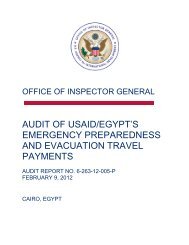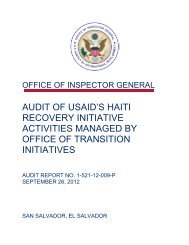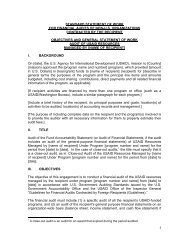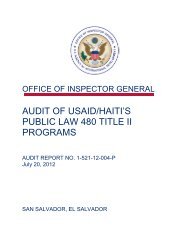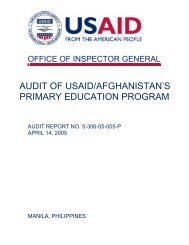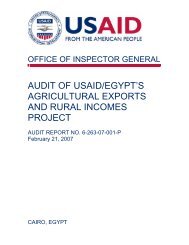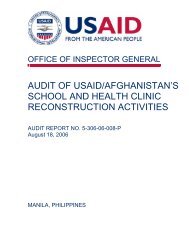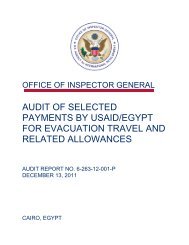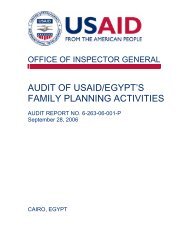USAID OIG Afghanistan and Pakistan Oversight Report, April-June ...
USAID OIG Afghanistan and Pakistan Oversight Report, April-June ...
USAID OIG Afghanistan and Pakistan Oversight Report, April-June ...
- No tags were found...
You also want an ePaper? Increase the reach of your titles
YUMPU automatically turns print PDFs into web optimized ePapers that Google loves.
<strong>OIG</strong>’s audit found that the university, with <strong>USAID</strong>/<strong>Afghanistan</strong>’s support, had increased student enrollment<strong>and</strong> improved school infrastructure, although the development of a new campus was behind schedule. Theuniversity had increased the number of qualified staff, one of the program goals. However, the universityhad not made progress in becoming self-sustaining. Despite increasing revenue from student tuition, it wasstruggling with fund-raising, which is essential for sustainability. As of May 2010, the university had raisedonly $4.5 million of the $14 million required <strong>and</strong> only $2.2 million had been collected, the remainderconsisting only of pledges. Additionally, although the university planned to raise $23 million in capital forthe construction of the new campus, as of May 2010, AUAf had identified only two donors; therefore, <strong>OIG</strong>questioned whether the university would be self-sustaining after U.S. Government funding ceases.The audit found that the university was also behind schedule in reforming its undergraduate program,which was making it less competitive with other private universities in <strong>Afghanistan</strong>. Furthermore, theUniversity’s Professional Development Institute had poor attendance because students lacked interest, <strong>and</strong>most of the reviewed course syllabi contained no written completion requirements. Because the universityhad not submitted required planning documents, including its second-year budget, the mission waswithholding additional funding. Further, the university was unlikely to meet its goal of increasingenrollment of women to 30 percent; Afghan cultural norms make families unwilling to send girls to anAmerican higher education facility because of the stigma of associating with people from other countries.In addition to documenting funding <strong>and</strong> curriculum problems, <strong>OIG</strong> found that the university did not followenvironmental procedures in construction of the new campus or in renovations of existing facilities.Audit of <strong>USAID</strong>/<strong>Afghanistan</strong>’s Partnership for Advancing Community-Based Education in <strong>Afghanistan</strong>(<strong>Report</strong> No. 5-306-11-001-P, October 28, 2010)This 5-year program was designed to exp<strong>and</strong> quality learning <strong>and</strong> life opportunities for marginalizedcommunities <strong>and</strong> their children in <strong>Afghanistan</strong>. The program’s core objectives were to exp<strong>and</strong> access tocommunity-based schools, strengthen community structures <strong>and</strong> processes that support basic education,<strong>and</strong> improve the quality of community-based education. Program activities were expected to directlybenefit a total of 93,240 students—of whom at least 60 percent were to be girls or women—in over 1,000communities in 90 districts <strong>and</strong> 20 provinces.Although the majority of program activities involved primary education classes covering Grades 1 through 6,the program also offered other types of classes, including early childhood development <strong>and</strong> adult literacy,for learners younger or older than primary school age (7 to 12 years old).The audit determined that the program was partially achieving its goals but was not offering its teachersbasic training to ensure that their students received a quality education. Results reported on this <strong>and</strong> otherprogram areas also were not adequately supported. In addition, efforts to integrate the program’s primaryclasses into the Ministry of Education system were not always implemented effectively.According to a progress report for the quarter ending March 31, 2010, program activities had resulted in theestablishment of 3,695 classes attended by 98,212 students—the majority of whom were girls—in a total of1,672 communities located in 97 districts <strong>and</strong> 19 provinces, meeting or exceeding at least some of theprogram’s targets. The program had also made progress in facilitating the integration of 51 percent of itsprimary classes into the Ministry of Education system.78 <strong>USAID</strong> <strong>OIG</strong> <strong>Afghanistan</strong> <strong>and</strong> <strong>Pakistan</strong> <strong>Oversight</strong> <strong>Report</strong>



